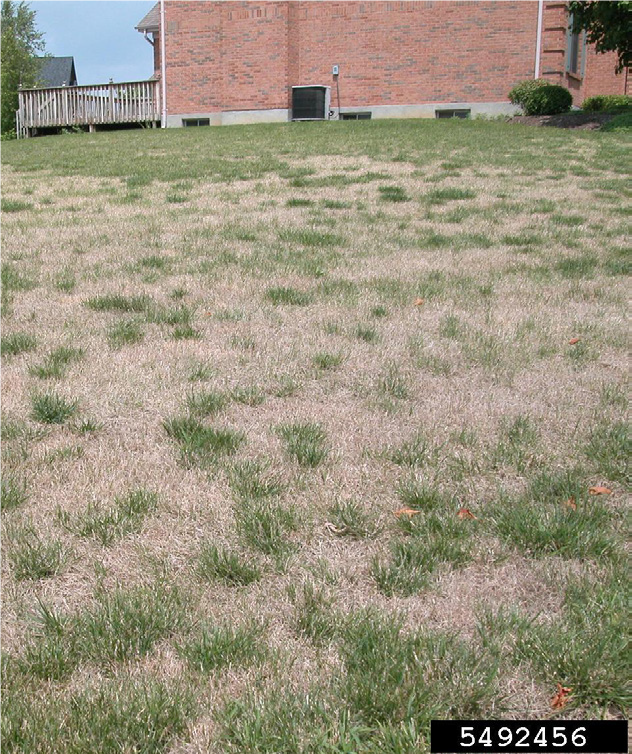The bluegrass billbug (Sphenophorus parvulus) was first reported in the United States almost 100 years ago in Nebraska. Since then, it has become a pest of turf grass throughout much of the country. Although its primary host is Kentucky bluegrass, it also attacks perennial ryegrass and fescue.

The Ohio State University, Bugwood.org.
Description
The adult bluegrass billbug is a gray, brown, or black weevil notable for its long snout. Its snout has chewing mouth-parts at the tip. The adult, 3/8 " long, is often found walking on pavement. The larvae are white and legless with a brown head capsule and feed within the stems and on the fibrous roots of grass.
Life Cycle
Spring: Overwintering adults emerge in May and lay eggs in stems during May and June.
Summer: Larvae feed on the stems and roots with the heaviest damage appearing in July and August.
Fall: New adults emerge in September and October and seek overwintering sites. There is one generation per year.

State University, Bugwood.org.
Management
IPM Strategies:
- Cultural Practices and Non-Chemical Controls -
-
Resistant and/or tolerant Kentucky bluegrass cultivars can help minimize risks of infestations. Check with your local seed supplier for suggestions.
-
Using endophyte-enhanced turfgrass seeds as part of your management program can help reduce the damage caused by bluegrass billbugs. However, Endophyte-enhanced seeds can negatively impact the health of livestock, so it is imperative that you follow all label directions regarding where you use these seeds.
- Monitoring - To monitor this insect, observe paved areas near bluegrass or primarily bluegrass lawns on sunny days in late May or early June. When two or more adults are observed per minute, damage along the adjacent turf area is expected. Pitfall traps may also be used for monitoring purposes.
- Chemical Control - Billbug injury is a mid-summer problem and not a spring or fall problem as with white grubs. The most reliable timing of application for New England appears to be June ans is targeted at small larvae.
Consult your county Agricultural Field Specialist for specific recommendations.

Stop! Read the label on every pesticide container each time before using the material. Pesticides must be applied only as directed on the label to be in compliance with the law. Contact the Division of Pesticide Control at (603) 271-3550 to check registration status. Dispose of empty containers safely, according to New Hampshire regulations.
Download the resource for the complete factsheet.

